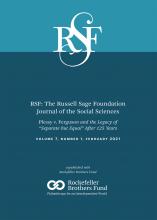Research Article
Open Access
Who Gets to Say Who’s Who? Plessy’s Insidious Legacy
Thomas J. Davis
RSF: The Russell Sage Foundation Journal of the Social Sciences February 2021, 7 (1) 32-49; DOI: https://doi.org/10.7758/RSF.2021.7.1.03
Thomas J. Davis
aProfessor emeritus at Arizona State University, Tempe, United States

REFERENCES
- ↵
- Alston, Andrew
- ↵
- Alterman, Hyman
- ↵
- Balkin, Jack M., and
- Reva B. Siegel
- ↵
- Bayefsky, Anne, and
- Joan Fitzpatrick
- ↵
- Berger, Bethany R
- ↵
- Bernstein, David E
- ↵
- Caplan, Jane, and
- John Torpey
- ↵
- Chin, Gabriel J
- ↵
- Crenshaw, Kimberlé,
- Neil Gotanda,
- Gary Peller, and
- Kendall Thomas
- ↵
- Davis, F. James
- ↵
- Davis, Thomas J
- ↵
- Davis, Thomas J
- ↵
- Davis, Thomas J
- ↵
- Davis, Thomas J
- ↵
- Diette, Timothy M.,
- Darrick Hamilton,
- Arthur H. Goldsmith, and
- William A. Darity Jr.
- ↵
- Dunbar-Nelson, Alice Moore
- ↵
- Dyson, Maurice R
- ↵
- Epstein, Daniel C
- ↵
- Feinberg, Leslie
- ↵
- ↵
- Gibbard, Frank
- ↵
- Green, Christopher R
- ↵
- Heitzeg, Nancy A
- ↵
- Hellum, Anne
- ↵
- Horan, Michael J
- ↵
- Jones, Bernie D
- ↵
- Kennedy, Randall L
- ↵
- Kurland, Philip B., and
- Gerald Gunther
- ↵
- Kuznicki, Jason
- ↵
- Linehan, Patrick F
- ↵
- Mack, Kenneth W
- ↵
- MacKinnon, Catharine A
- ↵
- Mahajan, Ritu
- ↵
- Marshall, Jill
- ↵
- Minter, Patricia Hagler
- ↵
- Nachbar, Thomas B
- ↵
- Ortiz, David R
- ↵
- Osborn, William S
- ↵
- Perlmann, Joel, and
- Mary C. Waters
- ↵
- Prewitt, Kenneth
- ↵
- Rabinowitz, Howard N
- ↵
- ↵
- Rainier, Elias
- ↵
- ↵
- ↵
- Rhode, Deborah L
- ↵
- Richardson, Megan
- ↵
- Roback, Jennifer
- ↵
- Ruchames, Louis
- ↵
- Safire, William
- ↵
- Sandoval-Strausz, Andrew K
- ↵
- Scott, Grinsell
- ↵
- ↵
- Siegel, Reva B
- ↵
- Skerry, Peter
- ↵
- ↵
- Tietje, Louis, and
- Steven Cresap
- ↵
- ↵
- ↵
- Welke, Barbara Y
- ↵
- Welke, Barbara Y
- ↵
- Whitby, Andrew
- ↵
- Williams, Jeffrey A
In this issue
Who Gets to Say Who’s Who? Plessy’s Insidious Legacy
Thomas J. Davis
RSF: The Russell Sage Foundation Journal of the Social Sciences Feb 2021, 7 (1) 32-49; DOI: 10.7758/RSF.2021.7.1.03
Jump to section
- Article
- Abstract
- ARRIVING AT THE TOUCHSTONE FOR JIM CROW
- SEPARATE CARS WERE NOT UNUSUAL
- SEPARATION REPLACED EXCLUSION
- “SEPARATE BUT EQUAL” TO SATISFY EQUAL PROTECTION
- PLESSY’S ARGUMENTS FOR IDENTITY
- PLESSY CHALLENGED THE BINARY
- THE MAJORITY’S SHORT SHRIFT
- SCRUTINIZING THE STATE POLICE POWER
- DISMISSING PERSONAL AUTONOMY OVER IDENTITY
- A REASONABLE DISMISSAL?
- CONSEQUENCES OF DISMISSAL
- A WAY FORWARD
- FOOTNOTES
- REFERENCES
- Info & Metrics
- References
Related Articles
- No related articles found.
Cited By...
- No citing articles found.





